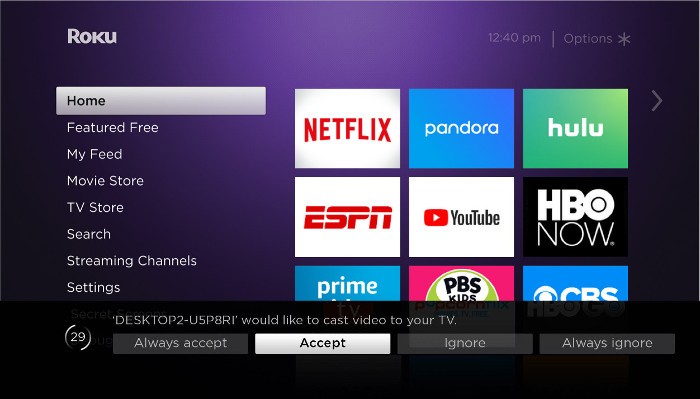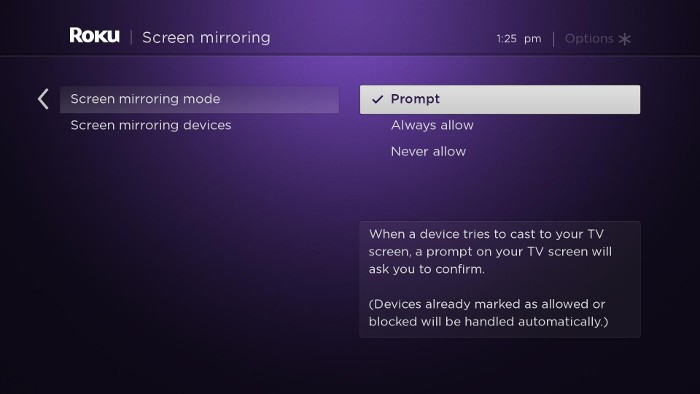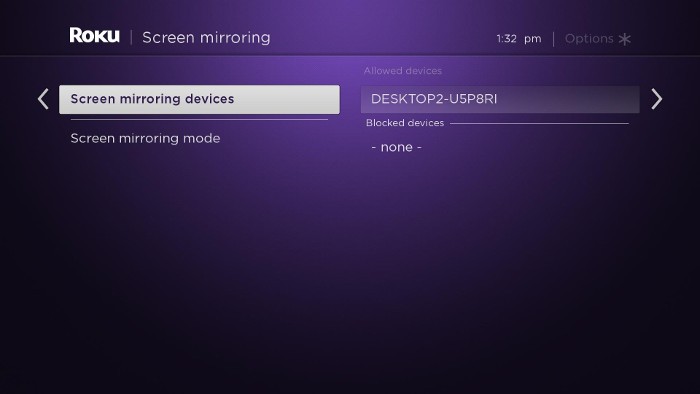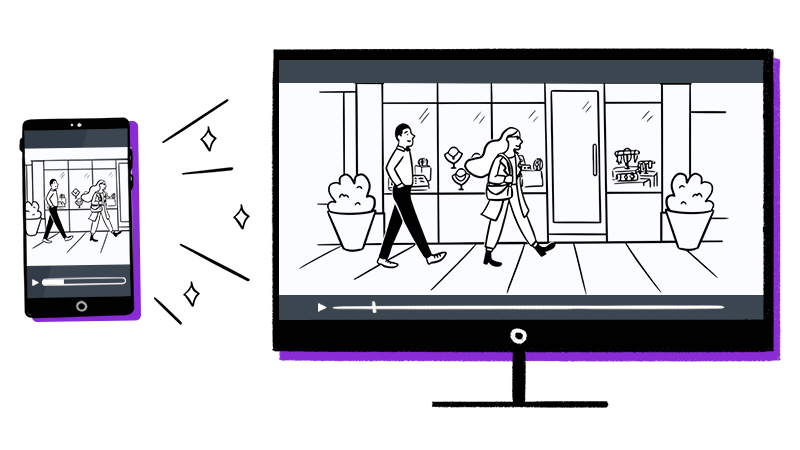Background
When you want to display content from your phone or tablet on a nearby TV, you may be able to use screen mirroring. This feature allows you to replicate (or “mirror”) the screen of your compatible Android™ or Windows® device wirelessly onto your TV screen. With screen mirroring, you can send web pages, videos, photos, music, and more to yourTV. In other words, whatever you see and do on your mobile device appears on your TV.
To use screen mirroring, you must first set up and enable the feature on your Android or Windows device and then request a connection to your device. Once a connection is established, you can see your mobile screen on your TV and control it from your phone or tablet.
Is screen mirroring supported on my iPhone or iPad?
No. Screen mirroring with a Roku device is not supported with iOS® or Apple devices. You can however, use your iPhone or iPad to:
- Cast content from compatible apps like YouTube and Netflix to your Roku device.
- Display personal photos, videos, and music using the Play on Roku feature built in to the free Roku mobile app.
Are casting and screen mirroring the same?
Even though the terms “casting” and “screen mirroring” are commonly interchanged in the industry, there are differences when using them with your Roku device.
- What content you can send. When casting, you can only watch content available from a mobile app that specifically supports casting. Screen mirroring allows you to view content from any app installed on your mobile device.
- What you see on your TV. With casting you only see playback of the selected piece of content, whereas with screen mirroring, you see the entire screen of your mobile device including buttons and menus – every action is mirrored on your TV.
- How you control playback. Casting gives you the option to use your mobile device for control or you can choose to use your Roku remote. During a screen mirroring session, all actions are controlled on your mobile device.
- Power state of your phone or tablet. Once playback begins, casting lets you use your mobile device to do something else or you can power it off entirely. Screen mirroring requires that your mobile device remain powered on for the duration of playback.
- Supported mobile devices. Casting is supported on most mobile devices – if you see a casting icon
 in the app, you can send content to your TV. Screen mirroring is limited to compatible Android™ and Windows® devices.
in the app, you can send content to your TV. Screen mirroring is limited to compatible Android™ and Windows® devices.
Can I share my personal photos and videos on my TV?
If you want to specifically share your personal photos and videos, or songs from the music library stored on your mobile device, you can use the Play on Roku feature of the Roku mobile app. The Roku mobile app is a free application for iOS® and Android devices.
To learn more about sharing personal media files from your compatible mobile device, read the detailed article about Play on Roku.
Do I need to enable screen mirroring on my compatible Roku device?
If your Roku device supports screen mirroring and is running Roku OS 7.7 or later, the feature is enabled automatically and there is no action required to enable it. To check the software version of your Roku device, go to Settings > System > About. If an older version is installed, connect your Roku device to the internet and have it manually check for a software update.
How do I screen mirror from my Android device?
With a long list of companies manufacturing Android devices, each with a variety of models, it may be difficult to determine if your Android device supports screen mirroring. In general, if your Android device is running version 4.2 or later (and is not a Google branded device running OS 6.0 or later like a Google Nexus or Pixel), it likely supports screen mirroring. However, it is not uncommon for manufacturers to use a different term when describing this feature. To assist with setting up and enabling screen mirroring on your Android device, here are some common terms used for screen mirroring.
Once you identify the term used by the manufacturer of your Android device, the screen mirroring feature is generally enabled from within the settings menu; often on a cast, connection, network or display submenu. After you enable the feature, select your Roku player or Roku TV from the list of discovered devices to request a connection.
To learn more about setting up screen mirroring on your Android device, refer to documentation for your device, or contact the manufacturer. You may also want to try an internet search using the term “screen mirroring” along with the brand and model of your device.
How do I allow or block a screen mirroring request?
When a screen mirroring request is made from your Android or Windows device, your Roku device displays an on-screen prompt across the bottom of your TV screen.

From the prompt, you can choose from the following options to allow or block the request.
- Always accept – Always allow content from the device to be screen mirrored to your Roku device without displaying the on-screen prompt for each future attempt. This action adds the device to a list of ‘Allowed devices’.
- Accept – Allow content from the device to be screen mirrored on your Roku device for this one attempt.
- Ignore – Block the current attempt and do not allow the device to connect to your Roku device.
- Always ignore – Always block an attempt from the device, and do not display an on-screen prompt for future attempts. This action adds the device to a list of ‘Blocked devices’.
Can I adjust screen mirroring settings?
You can define how an incoming screen mirroring request is handled by changing the screen mirroring mode on your Roku device. You can also remove a device that was added to the list of ‘Allowed devices’ or ‘Blocked devices’.
- Press the Home button
 on your Roku remote.
on your Roku remote. - Select Settings and then select System.
- Select Screen mirroring.
- After you open the screen mirroring settings, choose a setting to adjust.
-
- Screen mirroring mode – Select one of the choices to define how an incoming screen mirroring request is handled.

- Prompt – Each time a screen mirroring request is made, your Roku device will display an on-screen prompt, except in the case where ‘Always accept’ was selected from the prompt for a specific device.
- Always allow – A request from any device to mirror or cast its screen will be accepted without an on-screen prompt appearing.
- Never allow – Always blocks a screen mirroring request from any device without an on-screen prompt appearing. This is essentially a way to disable screen mirroring on your Roku device.
- Screen mirroring devices – Select a device in the list of ‘Allowed devices’ or ‘Blocked devices’ and choose to remove it. It is expected that either list will be empty if ‘Always accept’ or ‘Always ignore’ has never been selected from the screen mirroring prompt.

- Screen mirroring mode – Select one of the choices to define how an incoming screen mirroring request is handled.
